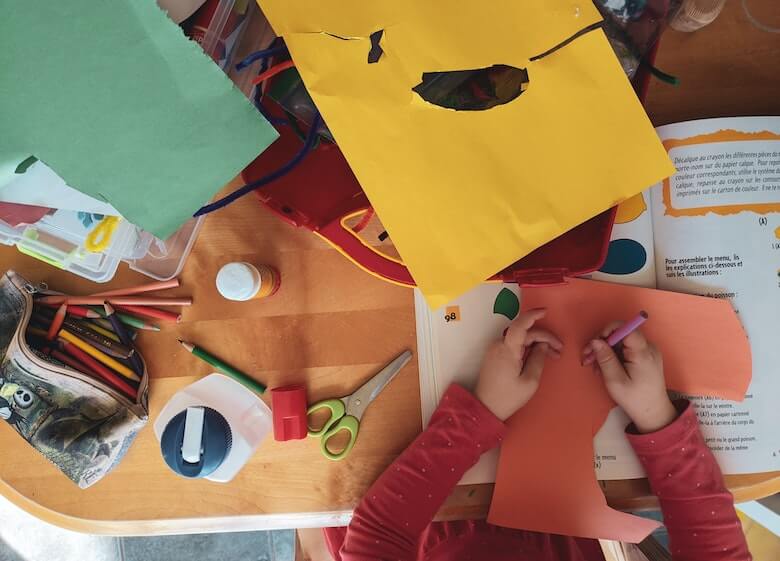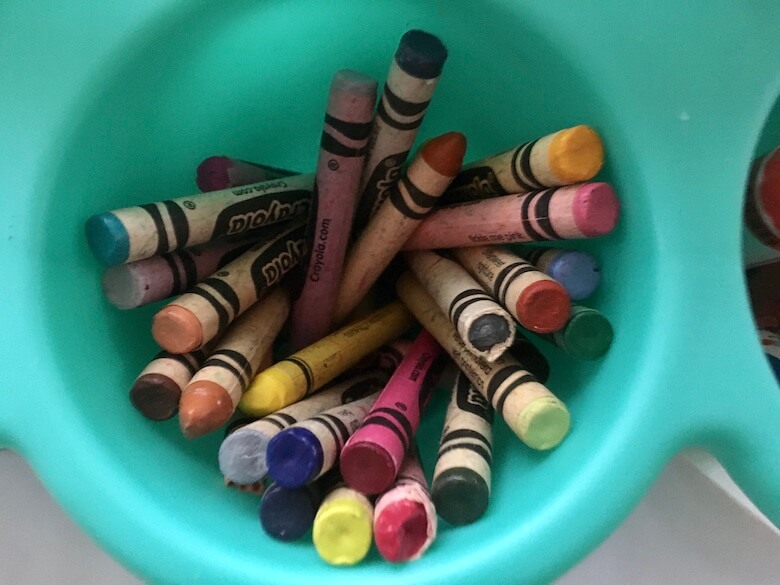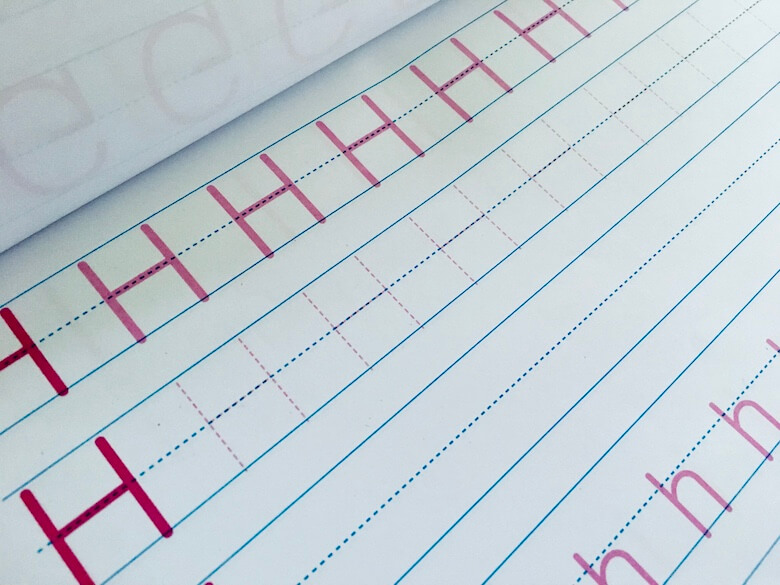
Writing in early childhood is good practice for fine motor skills and language development, as an extension of cognitive development. It can also be a creative outlet for children.
Below are ideas on how to teach preschoolers to write.
Start by teaching letters, phonics and spoken word communication
Writing comes after verbally and visually learning letters and the alphabet. It also comes after learning basic words, such as the names of colours, shapes or objects. This way, preschoolers can piece together the idea that writing is a symbolic form of language. They can put together letters to make words. Those words will have meaning if the preschoolers can recognize, speak and use them verbally, first. This principle also applies to numbers.
Of course, these stages of language learning often happen in the toddler years, or around 2 to 4 years old. However, if your child is behind, that’s ok! Start with what you can, when you can. If you suspect your child has a learning difficulty, definitely bring it up with your doctor. But know that all children learn at different speeds.
Read, read, read and read again to your children
In this process of learning how to write, it is crucial that children read and are read to frequently. At first, reading to children will be mostly about quality time, or story telling. However, a lot is happening in their brains as they listen to your spoken vocabulary, so don’t discount it. Eventually, you can ‘graduate’ preschoolers to understand that markings on the page are letters, which correlate to sounds.
Some books are designed to emphasize letter or digraph sounds, so children can learn to read. But you can do this with your child using any book. For example, when you see the word “cat,” slowly emphasize the sound of each letter and point to them as you pronounce their sounds. So you would say “Ca – Ah – Tuh” and point to the C, the A, and the T when you do.
Eventually you’ll want to ask the preschooler to start doing the same. Point at letters and ask what sound they make. Then try to string them together, to form words.
When you’re driving or going for a walk with your preschooler, look at signs and ask: “do you see the letter, “S”? Point out these letters and words often. Make it a fun game with them.
See more on our blog:
- Why is literacy crucial in the early years? How can parents and preschools help with reading skills?
- What is the best way to teach word recognition to early childhood readers?
- 5 Simple ways to teach preschoolers phonics basics
- How to teach digraphs to preschool children (6 ways)
Teach general fine motor skills, before teaching preschoolers how to write

Before children learn to write, they need to learn the basics of holding a pencil and making lines. Start by:
- Letting them trace shapes with their fingers in sand, flour, shaving cream or pudding
- Giving them crayons or paint and paper to make squiggly lines of any kind
At first, children will hold crayons in all different ways. This is totally fine in the beginning. Use thicker crayons to help them learn how to grasp these objects.
However, eventually, you should encourage fine motor skills in the way of using their little fingers and hand muscles. For example, they should practice their pincer grasps before, or around the same time they try their pencil grasp.
You can also give children little beads to organize or thread, googly eyes to glue down, and tweezers to pick up bugs. Let them hold straws in their juice cups, use utensils during meal times, pick tiny flowers or berries and so on. Always encourage them to use their hands. Even playdough and poking things with sticks can count!
See more on our blog:
Teach preschoolers to trace straight lines on paper
Next comes tracing. Lots and lots of tracing. However, you don’t want to start by immediately asking a child to trace the letter “A.” Instead, break things down into simpler concepts. For example, tracing a straight vertical line, and then a horizontal line. Then a diagonal line. Then a circle or curve. And so on.
This video on YouTube explains this concept in more detail, and shows the type of printable worksheets you can use for this type of initial tracing exercise:
Teach preschoolers to colour, trace and copy letters
To familiarize children with the shape of individual letters, use printed outlines of letters and ask them to colour them in.
Then, you can use ‘connect the dots’ or ‘dashed’ letters and numbers. There are several books that you can buy for this, or you can print your own from the web, or even make your own. Just make sure the letters are large enough at the beginning to help children with their often broad strokes. Eventually, they learn to gain more and more control of their pencil, to write smaller, and within lines.
With letters, most people start with capital letters, since they are easier to draw.
Ask your preschoolers to keep their pen markings in line with the dots. Make sure the dots make a visible letter they can see before they begin tracing (i.e. the dots should be close together).
Eventually, you can make these tracing sheets with the dots further and further apart, until the child can control their pen enough to reach the next dot. Using connect-the-dots colouring and activity books can help with this. Just get children used to tracing lines, even if they’re not always letters.
It’s also important to emphasize good letter-drawing habits at this stage. For example, with the letter “T”, teach children to draw the vertical line first, and then the horizontal line.

Some people use sheet protectors, or they laminate these tracing worksheets, so they can be used over and over again with dry-erase markers. This is optional, however. You can use paper, a chalkboard, an LED drawing board, or a magnetic drawing board for this activity.
Finally, when they’re ready, and while a printed letter is in front of them, ask your preschooler to copy the letter, instead of tracing over it. In other words, they should learn how to write letters and numbers without a tracing guide.
Teach children to write several letters in a line
When children have learned how to draw letters, it’s time to teach them to keep those letters in a straight line. It’s also time to show them the spacing requirements between letters, so that they can form words, and tell words apart.
To make this part fun, teach your child to write something they’ll love: their name!
Next they can do your phone number or address. Or their friends’ or animals’ names. Or how about, “I love you”?
Teach them to write what they enjoy, and don’t be afraid to make it fun and silly. If a preschooler wants to write the word “poo,” well, don’t be surprised!
At this point, you may want to also begin introducing punctuation, like exclamation points or periods.
As children first learn to write, they will likely go outside the horizontal lines on a sheet of paper you give them to do this. Kindly redirect them back to staying within the lines, so they understand it as a requirement of writing. If their letters are too far spaced apart, encourage them to write them closer together.
Remember that at this point, they may not know how to spell yet. So, you’ll need to be present with them to tell them what letters come first, second, third etc. for each word they want to write. Spelling will come next, don’t worry! The point is to spend time with them to do this.
Practice, practice, practice
Finally, it goes without saying that practice really does make perfect! As adults, we can probably barely remember when we first learned to write the ‘right’ way, since it comes so naturally to us now. This is a product of frequent practice.
In a similar vein, always make chalk, drawing boards, crayons and paper available to your child, so they can practice writing and drawing every day. You can even encourage them to keep a nightly journal where they write what they did that day, or what they are thankful for. For example, they may be thankful for “teddy” one night. They can just write that one word, it’s ok. Eventually, they can write things like “I ate ice cream” or “it’s my birthday.” The sentences can get longer and longer, and eventually there can be more than one sentence.
Also encourage them to write cards to their friends and family. Teaching them how the mail system works will be fun in itself – they can eagerly await replies in the mailbox!
Whatever it is, however you do it, write every day with your preschooler.
See more on our blog: